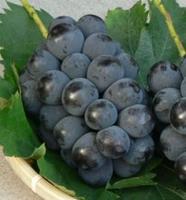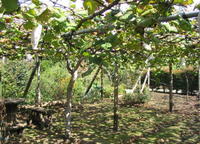:::::::::::::::::::::::::::::::::::::::::::::::::::::::::::::::::::::::::::::::::::::::::::::::::::::
Grapes (budoo) and wine
***** Location: Japan, Europe, other areas
***** Season: Various, see below
***** Category: Plant
*****************************
Explanation
Grapes, and one of their products, the wine, give us pleasure during the whole year. Here I will introduce some kigo related to this fruit.
The origin of the grapes is probably Western Asia, but now it is grown almost everywhere in the world. In Japan, grapes were introduced during the Heian period in a special way, using separate shelves for each plant. Now the region of Kooshuu 甲州 in Yamanashi is maybe the most famous wine-growing area.
In my area of Okayama prefecture, Japan, huge pione grapes are grown for eating (or rather giving away as presents), since they are extremely expensive.
Gabi Greve, September 2005

Look at a few more PIONE photos
岡山のピオーネ
http://www.bizen-okayama.com/pione/index.html
:::::::::::::::::::::::::::::::::::::::::::::::::::::::::::::::::::::::::::::::::::::::::::::::::::::
SUMMER
flowers of the grapes, budoo no hana 葡萄の花
..... kigo for early summer
The flowers are very small and of a yellow-greenish color. They look almost like the stem, but they have a faint sweet smell.

http://www.furano.ne.jp/melon-ikeda/photo/photo45html.htm
kigo for late summer
aobudoo, ao budoo 青葡萄 (あおぶどう) green grapes
xxxxxxxxxxxxxxxxxxxxxxxxxxxxx
AUTUMN
kigo for early autumn
wild grapes, mountain grapes, yamabudoo 山葡萄
Vitis coignetiae)
They are extremely delicious and loved by the wild animals too. They can grow in colder areas than the usual grapes. In autumn, they also show a lovely red color of the leaves. When ripe, the small fruit are almost black. They make a delicious wine out of it in my area in Okayama, Japan. You can only drink it when someone gives a bottle as a present, it is just tooo expensive.
Two more types of wild grapes as kigo
nobudoo 野葡萄 (のぶどう) wild grapes
Ampelopsis brevipedunculata Ampelopsis
hebibudoo / jabuoo 蛇葡萄(へびぶどう)"serpent grapes"
Ampelopsis brevipedunculata var.heterophylla
xxxxxxxxxxxxxxxxxxxxxxxxxxxxx
kigo for mid-autumn
grapes, budoo, budō 葡萄
Muscat マスカット
Pione ピオーネ
grapes from Kooshuu, kooshuu budoo 甲州葡萄
black grapes, kuro budoo 黒葡萄
vinyard, budoo-en 葡萄園
shelf for growing grapes, budoo tana 葡萄棚

http://www12.plala.or.jp/grapes/tana/tana.html
:::::::::::::::::::::::::::::::::::::::::::::::::::::::::::::::::::::::::::::::::::::::::::::::::::::
kigo for late autumn
red leaves of the vine, budoo momiji 葡萄紅葉
budooshu kamosu 葡萄酒醸す (ぶどうしゅかもす)
to make wine
. . . budooshu seisu 葡萄酒製す(ぶどうしゅせいす)
. . . budooshuu tsukuru 葡萄酒作る(ぶどうしゅつくる)
. . . wain tsukuru ワイン作る(わいんつくる)
. . . wain matsuri ワイン祭(わいんまつり)
***** Grape Festival (Winzerfest, Wine festival)
WASHOKU
Japanese wine
:::::::::::::::::::::::::::::::::::::::::::::::::::::::::::::::::::::::::::::::::::::::::::::::::::::
kigo for all winter
dried vine plants, budoo karu 葡萄枯る
*****************************
Worldwide use
China
Dancing under the Grape Shelves in the oasis Turfan
Look at a beautiful photo here:
http://dsr.nii.ac.jp/photograph/turfan/0052.html.ja
xxxxxxxxxxxxxxxxxxxxxxxxxxxxx
Germany
Trauben. Weinberg. Weinlese, Traubenlese.
*****************************
Things found on the way
The Father of Japanese Grapes and Wine
Kawakami Zenbei
The history of wine in Japan goes back to the beginning of the Meiji Era (1868-1912). At that time, young grapevines were imported with official encouragement from the government and winemaking was attempted. However, it was difficult to adapt it to the Japanese climate and almost all attempts at growing grapes or making wine ended in failure.
In 1890, Kawakami Zenbei set up the Iwanohara Vineyard in Takada, in snowy Niigata Prefecture and three years later, using grapes he had harvested with his own hands, began making wine.
Read more of this pioneer here:
Kawakami Zenbei
xxxxxxxxxxxxxxxxxxxxxxxxxxxxx
2. Japanese wine production
Legend has it that grape-growing began at Yamanashi, where is major wine and grape produce region now. Wine may have been made from local grapes in Yamanashi in early times and consumed very locally. Yamanashi has the least rainfall and less fatalities soil, therefore rice can not be grown in Yamanashi. It is not difficult to assume that people live in Yamanshi compelled to drink wine instead of rice wine called "sake" which is more popular alcohol beverage.
In 1875, the first commercial winery was established in Katsunuma, Yamanashi, which is now a part of Mercian winery which is the second largest company in Japan.
As Mt Fuji provide rain shadow effects in Kofu Valley, Yamanshi has the least rainfall in Japan. But it still has excess 1000mm annual and 800mm rainfall during growing season. Especially, flowering season, in June and early in July is a monsoon season, this causes serious downy and powdery mildew problems. Worthily, just before harvesting, in September, we have typhoon season, sometimes it causes wind damage as well as bunch rot problems. Excess water and fertile soils makes vine vigorously, grape quality can be reduced without careful yield control.
Read a lot more about the
Japanese Wine Industry
*****************************
HAIKU
山葡萄むらさきこぼれる山日和
yamabudoo murasaki koboreru yama-biyori
wild grapes -
purple shimmers through
on a fine day in the mountains
(Tr. Gabi Greve)
水原秋桜子 Mizuhara Shuuooshi
http://www.cityfujisawa.ne.jp/~m-itazu/autum.html
xxxxxxxxxxxxxxxxxxxxxxxxxxxxx
わが腋も葡萄の花をこぼすべし
waga waki mo budoo no hana o kobosubeshi
阿部青鞋 Abe Seiai
http://tinyurl.com/9djx5
xxxxxxxxxxxxxxxxxxxxxxxxxxxxx
葡萄食う一語一語の如くにて
budoo kuu hitokoto hitokoto no gotoku nite
munching grapes -
like saying one word
and one more word
(Tr. Gabi Greve)
中村草田男
.....
待つといふことの寂けさ青葡萄
matsu to iu koto no sabishikesa ao-budoo
how lonely it is
to wait for someone -
green grapes
(Tr. Gabi Greve)
林翔 Hayashi Shoo
http://www1.ocn.ne.jp/~yamabito/special/pc_qa/haiku_saijiki_021225.html#n47
xxxxxxxxxxxxxxxxxxxxxxxxxxxxx
kuroki made murasaki fukaki budoo kana
purple unto
blackness:
grapes!
Masaoka Shiki
http://terebess.hu/english/haiku/shiki.html
xxxxxxxxxxxxxxxxxxxxxxxxxxxxx
Reife
Der Herbst reift ins Jahr.
Sonnenselig räkeln sich
Die vollen Trauben.
© Hans-Jürgen Murer
http://kurztexte.de/zKATJA/haiku/haiku01_04.htm
xxxxxxxxxxxxxxxxxxxxxxxxxxxxx
> > um den jungen Trieb
> > ein Band knüpfen –
> > lose
> > Pfirsichblüten
> > zwischen den Rebstöcken
> > die jungen Triebe abgebissen
Gerd Börner, 2005
xxxxxxxxxxxxxxxxxxxxxxxxxxxxx
All of New England
in a jar of wild grape jelly
and a clambake
© Helen Stiles Chenoweth
http://www.ahapoetry.com/PP900..htm
:::::::::::::::::::::::::::::::::::::::::::::::::::::::::::::::::::::::::::::::::::::::::::::::::::::
grape smell
invite us for a hike
in the autumn hills
Alex Serban, Romania
autumn 2010
*****************************
Related words
***** Grape harvest (Weinlese, Traubenlese, Vendanges)
kigo for autumn
France
Début des vendanges
Le coteau n'est plus, dès l'aube
Qu'un vaste parking
HAIKU DE COEUR
http://tinyurl.com/76k76
:::::::::::::::::::::::::::::::::::::::::::::::::::::::::::::::::::::::::::::::::::::::::::::::::::::
***** Wine pressing, Stoarcerea strugurilor (Romania)
usually October,
Kigo for Autumn
pressing Riesling grapes
in the most high-tech fashion—
the song is the same …
watching the courtyard
and thinking of my father—
wine-pressing season
the “boring” neighbour
to whom no one will talk, joined
the wine-pressing rush …
Cristian Mocanu
.....................................................................................
***** Sweet Wine, Must (Romania) Most (Germany)
In October, even cityfolk get to enjoy sweet wine in (sometimes open air) locales. A whole range of urban folklore has flourished in connection with this Must.
Cristian Mocanu
For more see Romanian Saijiki
:::::::::::::::::::::::::::::::::::::::::::::::::::::::::::::::::::::::::::::::::::::::::::::::::::::
continue here:
***** Grape Festival (Winzerfest, Wine festival)
WASHOKU : Yamabudoo 山葡萄 wild grapes
:::::::::::::::::::::::::::::::::::::::::::::::::::::::::::::::::::::::::::::::::::::::::::::::::::::
Back to the Worldkigo Index
http://worldkigodatabase.blogspot.com/
:::::::::::::::::::::::::::::::::::::::::::::::::::::::::::::::::::::::::::::::::::::::::::::::::::::
























